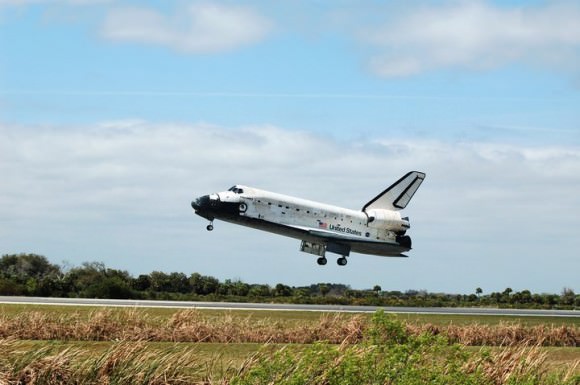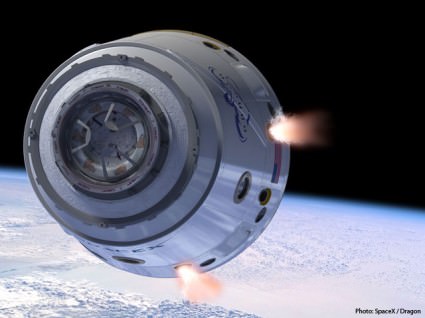[/caption]
NASA has announced the winners of the four second-round agreements under the Commercial Crew Development (CCDev2) program. These companies will now be awarded between $22 million and $92 million for their proposals. These funds will be used to help the winning commercial firms to develop and improve their concepts for bringing NASA astronauts to space.
These concepts cover both launch vehicles and the spacecraft that ride on them. NASA has selected Blue Origin and granted them $22 million, Sierra Nevada Corporation with $80, Space Exploration Technologies (SpaceX) with $75 million and Boeing with $92.3 million.
SpaceX said via Twitter that they will be ready to fly the first manned mission three years after receiving these new funds.
![SNC_Dream_Chaser_KSC_Launch[1]](https://www.universetoday.com/wp-content/uploads/2011/04/SNC_Dream_Chaser_KSC_Launch1-580x464.jpg)
“The next American-flagged vehicle to carry our astronauts into space is going to be a U.S. commercial provider,” said Ed Mango, NASA’s Commercial Crew Program manager. “The partnerships NASA is forming with industry will support the development of multiple American systems capable of providing future access to low-Earth orbit.”
The CCDev initiative was started back in 2009 with the intent of jump-starting the aerospace community into expanding U.S. spaceflight capabilities. CCDev2 is designed to speed up this process and reduce the gap in the nation’s human spaceflight abilities (when space shuttle Atlantis completes its final mission this summer, the U.S. will essentially lose the ability to send astronauts into orbit).

CCDev2 saw an explosion of proposals for a variety of spacecraft, SpaceX, Orbital Sciences, Boeing, Blue Origin, Alliant Techsystems and Sierra Nevada all submitted ideas. It is hoped that new space markets might arise out of this project which could see an expansion of customers – both commercial and government.
“We’re committed to safely transporting U.S. astronauts on American-made spacecraft and ending the outsourcing of this work to foreign governments,” said NASA Administrator Charles Bolden. “These agreements are significant milestones in NASA’s plans to take advantage of American ingenuity to get to low-Earth orbit, so we can concentrate our resources on deep space exploration.”

A wide range of both established and new space companies entered submissions. Utah’s Alliant Techsystems (ATK) had proposed Liberty, a partnership between them and the European space company Astrium (the producers of the Ariane rocket). Orbital Sciences entered a mini space shuttle and United Space Alliance (USA) entered a proposal that would have seen the space shuttles Endeavour and Atlantis continue to fly under the rebranded Commercial Space Transportation System.


And may the best companies/designs win…!
However, from 1963-1965, several lifting bodies were launched suborbitally on Thor boosters, to determine their re-entry characteristics. They were likewise exposed on the nose of the Thors, without farings.
http://en.wikipedia.org/wiki/ASSET_%28spacecraft%29
So, it can be done…
Yeah… I’d fly a Dragon into space today if I had the opportunity! Let’s GO! The Sierra Nevada Corps. Dream Chaser is also very interesting. They’ve taken an early NASA funded Northrup design, the HL-10. They’ve updated and expanded the design… and that ship is looking GOOD! SNC is definitely going into space!
http://www.nasa.gov/centers/langley/news/factsheets/HL-20.html
@ Aqua
I love the concept art as well.
The Dream Chaser’s improved lifting body has exposure during liftoff and travel through the thick-but-thinning atmosphere, this will have a non-negligible impact on the rocket lower path and orientation and will require more work from the paired thruster’s gimbals. Just my two cents here.
Mike C
– First, good for US! Especially the inclusion of SpaceX this time around, which are known to deliver. (I note that both Blue Origin and Boeing is late on their CCDev1 deliveries.)
– Second, am I cynical or plain conspirationist nutty if I note that:
The first time around the Constellation was “awarded” most of the money (2/3 diverted by a Rep senator).
This time Constellation is gone, but Boeing (Apollo, SST, ISS contractor) gets the lion share.
Boeing’s CST-100 is a Dragon clone (Constellation didn’t have an APAS ISS docking system), but likely without the non-LEO return capabilities (durable heat shield).
Funny that.
– Dream Chaser is now an interesting alternative. They have teamed up with Virgin Galactic for commercialization and WK2 drop tests. I didn’t see that one coming!
Perhaps they can now use a WK2 and a small booster combo for suborbital commercialization on their way “up”.
“will have on-board propulsion utilizing SNC’s proprietary hybrid rocket motor technology”
Maybe it doesn’t need a booster at that.
Well, conspiracy or not, CST-100 will be still much cheaper (for US taxpayers, that is) than Orion…
I predict you that it is not going to be cheaper for the tax payer.
Some companies will use the money and then somehow make that money disappear when the project fails.
Also there is a likelihood that when one of those companies get busted that they get sold at the Chineese and they get the inventions payed by the US taxpayer for free.
hi olaf, do you have any examples you could site of why this would be likely? Thanks
I worked in a private company that got government funding to develop new technology. The R&D team really did work hard but not all the money ended up at the R&D team.
I predict you that it is not going to be cheaper for the tax payer
No personal offense intended Olaf, but based on what benchmark? Ares 1? IIRC, NASA Deputy Administrator Lori Garver is picking 60% cheaper than a NASA in-house equivalent system.
The 17 page “Selection Statement for Commercial Crew Development Round 2” describes how NASA’s Participant Evaluation Panel ranked the twenty two CCDev2 wannabes, finally backing these four as top-of-the-class on the basis of full disclosure for costs details, risks management, best practice, acceptable performance milestones, due diligence etc. For all of it’s faults, NASA isn’t some dumb used car buyer that just wandered onto the lot (although Congress is giving an excellent impression of a back seat driver at the moment). NASA provides significant oversight, knows what it needs and, with a fixed budget, is keenly aware of what it is not prepared to pay for, sunk costs due to further participant elimination not withstanding.
Again, no offense, but you’ve offered a prediction which would be particularly disappointing if it panned out.
Just wait and see what happens in a couple of years. 🙂